Vital Statistics
In 2021, number of deaths exceeds that in 2020 and current series records lowest number of births
February 16, 2023 10h00 AM | Last Updated: February 22, 2023 02h30 AM
Highlights
- In 2021, second year of the Covid-19 pandemic, the number of deaths in the country increased by 18% and hit approximately 1.8 million. The annual growth rate and the total of deaths were record figures in the time series that started in 1974.
- The increase in the number of deaths in 2021 beat that in 2020 among adults aged 40 to 49 (35.9%) and 50 to 59 years of age (31.3%). In the group aged 70 to 79 and 80 years of age and over increased less than in the previous year.
- umber of births drops 1.6% and hits 2.6 million, lowest total births in the series considered from 2003 on. This indicator also fell in 2019 (-3.0%) and in 2020 (-4.7%).
- A total 932.5 thousand marriages were registered in 2021, with an increase of 23.2% before 2020. Despite the increase, the current number of marriages has not yet reached pre-pandemic levels.
- There were 9,202 marriages between same-sex persons in 2021, an increase of 43.0% from 2020 (6,433).
- In 2021, the number of divorces granted at trial court level or by means of out-of-court settlements reached 386.8 thousand, with an increase of 16.8% from 2020. That was the highest percentage against the previous year since 2011 (45.4%).
- The proportion of divorces with shared custody of minor children went from 7.5%, in 2014, to 34.5%, in 2021. Law no. 13,058, of 2014, set a priority for this mode in divorces between couples with minor children.
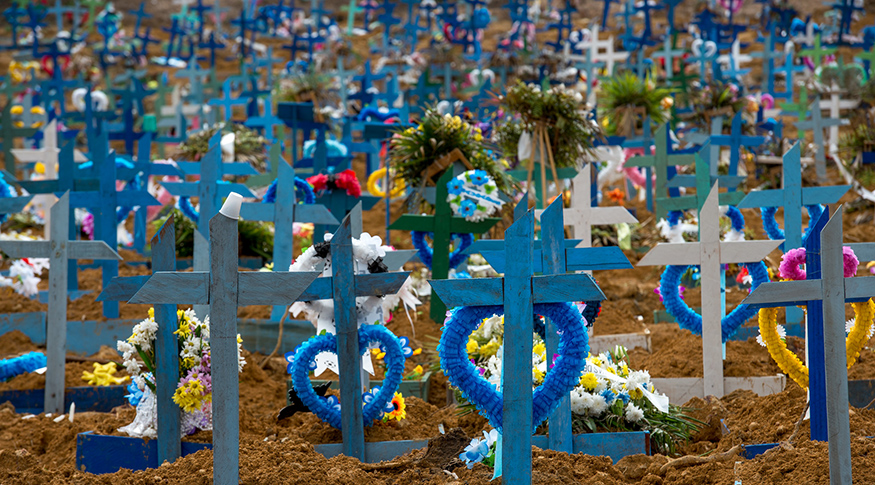
The number of deaths increased by 18.0% in 2021, about 273 thousand deaths more than in 2020, which amounts to approximately 1.8 million and reachs a new record in the series: that was the highest absolute figure and highest percent change from the preceding year, since 1974. The number of births fell by 1.6%, a drop by about 43 thousand births, being close to 2.6 million, lowest level in the series, considering data from 2003 on, when a methodological change in the indicator took place. These pieces of information are part of the Vital Statistics, released today (16) by the IBGE, which also present data on marriages and divorces.
The Covid-19 pademic affected the demographic arrangement of the country significantly. When demography conducts studies, projections are based on a somewhat stable scenario. But the number of births was way below the figure estimated by the IBGE and the number of deaths was higher,” says the survey manager Klívia Brayner.
In 2020, the number of deaths had already reached its highest level (about 1.5 million), showing the highest change in the entire series (14.9%, about 196 thousand more deaths). As the pandemic went on, the number of deaths in 2021 recorded an increase above that in 2020. Against 2019, the increment amounted to 469 thousand more deaths. In the period before the pandemic, from 2010 to 2019, the average annual increase of deaths had reached 1.8%.
That took place mainly in the 1st semester of 2021. The month of March stood out with the biggest number of deaths (202.5 thousand), a figure 77.8% higher than in March 2020. From July 2021 on, there was a trend to decrease, and, from September on, the number of deaths started to fall in comparison with the previous year.
“The implementation of sanitary measures and, later, the start of campaigns to promote vaccination may have added to the retreat of the pandemic and its consequences. The decrease in the number of deaths and the advance of vaccination are clearly related,” the manager states.
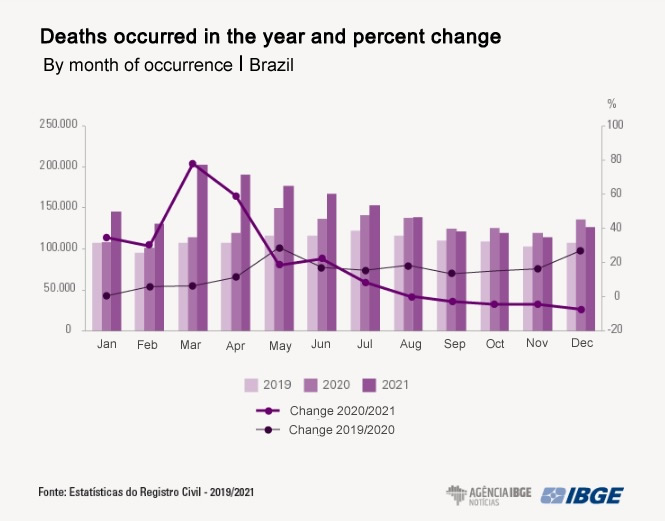
The regional panorama of deaths points to a very different scenario from that observed in 2020. The South Region, which, between 2019 and 2020 was the least affected in terms of relative change of deaths, recorded an increase of 30.6% from 2020 to 2021, the highest among the Major Regions, followed by the Central West (24.0%) and Southeast (19.8%). The North (12.8%) and Northeast (7.1%) registered levels below the national average. In 2020, the North Region, with an increase of 26.1%, had recorded the biggest relative change in deaths.
The analysis by age groups shows that the increase in the number of deaths in 2021 was more intense than in 2020 among adults aged 40 to 49 (35,9%) and 50 to 59 (31.3%). Elderly persons aged 70 to 79 and 80 and over had increases below those in the previous year.
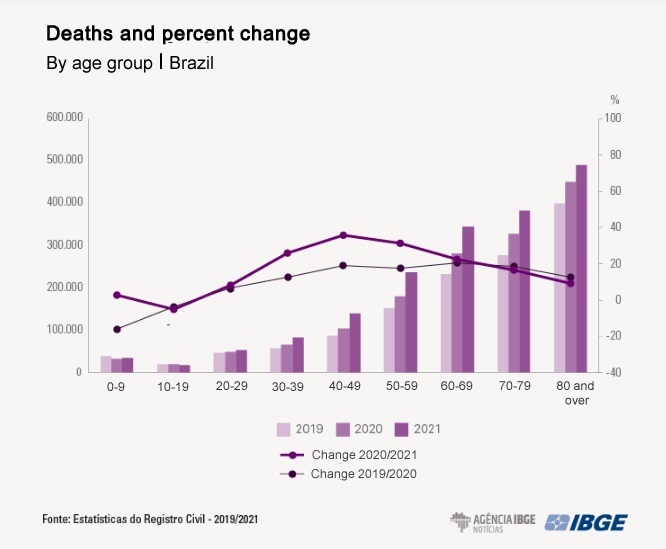
Birth registers drop for the 3rd consecutive year
In 2021, 2.7 million birth were registered in registry offices in Brazil. Against 2020, there was a decrease of 1.6% in the number of birth registers, corresponding to a reduction by 43.1 thousand births. Of the total births, 2.6 million were relative to children born in 2021 and registered up to the 1st semester of 2022, and approximately 3% (73 thousand) corresponded to persons born in previous years or whose year of birth is unknown.
“The drop of birth registers, observed for the third consecutive year, seems to be related to the reduction of births and fertility in the country, already indicated by the latest \census editions. Another possibility is that the pandemic has caused insecurity between couples, causing the decision for pregnancy to be postponed,” says Klívia.
Between 2018 and 2019, the reduction of births was approximately 3.0% (about 87.8 thousand). Between 2019 and 2020, 4.7% (a decrease of 133 thousand births). When the annual average of births occurred from 2015 to 2019 is analyzed (about 2.9 million years), five years before the pandemic, there was a reduction by 232,625 births, which is equivalent to 8.1%.
As for the birth registers of children, the same behavior of previous years remained, with the highest number in March (239 thousand), followed by the month of May (237.3 thousand), whereas November recorded the biggest number of births (205.4 thousand).
Between the years of 2020 and 2021, the decrease of birth registers was above the national average in the Southeast (-4.0%) and South (-3.1%), and below in the Central West (-1.1%). In the North and Northeast the number of birth registers increased by 4.3% and 0.1%, respectively.
“In the analysis of the mother’s age at the time of birth, in 2000, 2010 and 2021, there was progressive change in the structure of births in the country.” In 2000, more than 54.0% of the births were from mothers aged between 20 and 29 years. In 2010, this percentage changed to 53.1%, whereas that of live births from mothers aged 30 to 39 went from 22.0% in 2000 to 26.1% in 2010. In 2021, the participation of mothers aged 20 to 29 fell to 49.1% of the births, whereas that of mothers aged 30 to 39 increased by 33.8%.
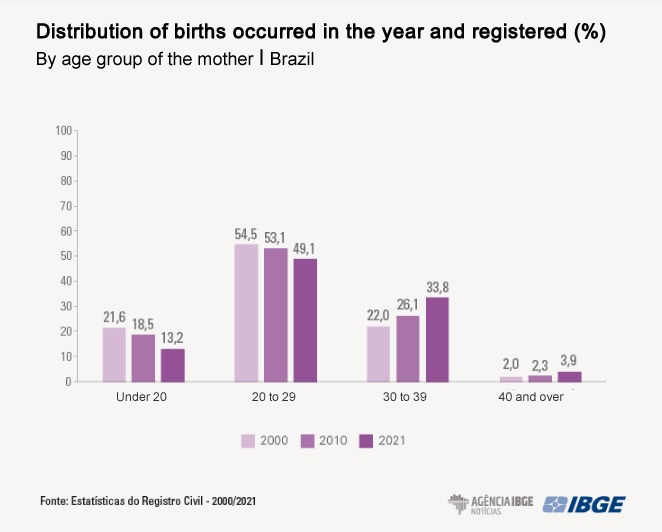
In spite o the increase in 2021, marriage registers do not exceed pre-pandemic level
In comparison with civil marriage registers, there were 932.5 thousand in 2021, an increase of 23.2% from 2020. Since 2015, the number of marriages has been on a downward trend. Between 2019 and 2020,during the pandemic, decrease was even more significant (26.1%).
“The average from 2015 to 2019 exceeded 1 million registers. Against the previous year, there was an improvement, and people were once again taking part in social gatherings and parties. This positive moment encouraged couples, but not at levels close to those before the pandemic,” says Klívia.
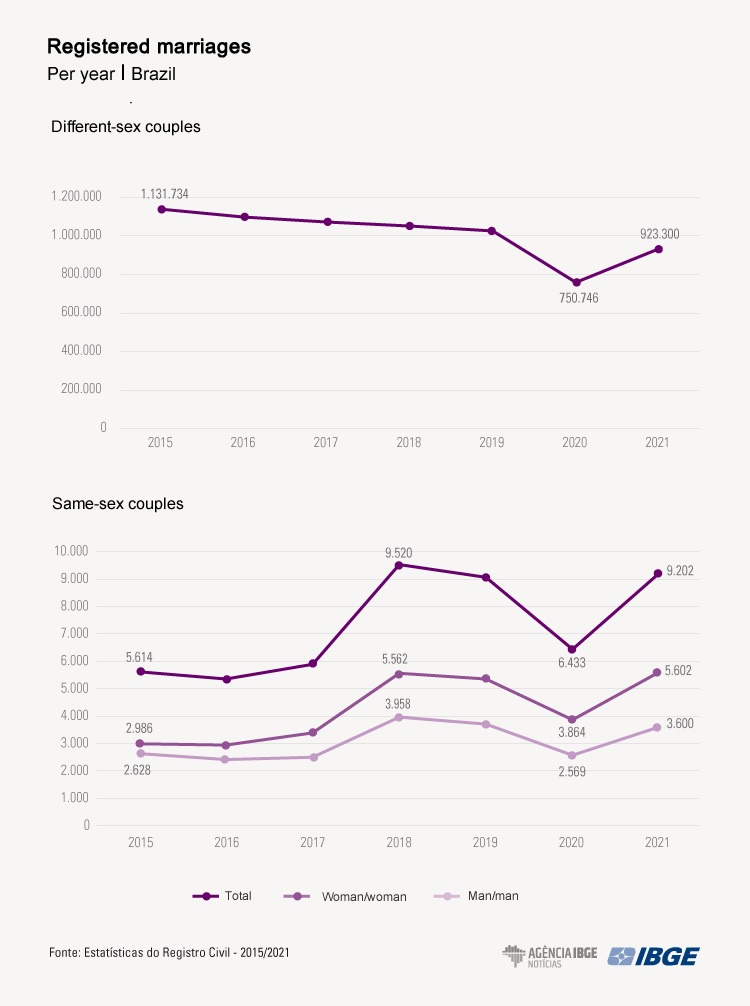
Among the total registers, 9,202 were marriages between same-sex persons, an increase of 43.0% from 2020 (6,433). Marriages between female partners were 60.9% of the civil marriages with this marital arrangement in 2021.
“It is important to highlight that the survey considers only civil marriages. Common-law marriage, even when registered, is not part of this survey,” the survey manager highlights.
Nuptiality rate - number of marriage registers in relation to the population aged 15 and over, is 5.5 per every 1,000 residents. The Northeast and South regions recorded the lowest rates (4.9 and 4.8 marriages, on average, per 1,000 inhabitants), whereas the Southeast (6.0) and Central-West (6.3) regions recorded the highest rates.
Divorces increase by 16.8% between 2020 and 2021
The number of divorces effected at trial court level or by means of out-of-court arrangements increased by 16.8% in 2021, having reached 386.8 thousand. As a result, the general rate of divorces (number of divorces per one thousand persons aged 20 and over) also increased, having changed from 2.15‰ (2020) to 2.49‰ (2021).
The manager calls attention, however, to the difficulties faced by the IBGE to collect information, as explained in the technical note.
“The IBGE regularly has difficulties in obtaining data on divorces, hwich can be solved by means of a dialogue between State Superintendences and State Justice Internal Affairs Departments. Problems grew after the computerization of Courts and the suspension of face-to-face services in the pandemic, problems increased, and the access to systems got more difficult every day.
The manager highlights that the IBGE does not collect names, document numbers, addresses or any data that can be used to identify persons taking part in the process, only the necessary information for statistical production. Even so, many times the institute’s agent cannot get a permission for data collection.
“As a result, time comparisons or the use of some geographic segmentation must be used with caution, considering the possible underenumeration of the data presented.”
From 2010 to 2021, the average period of time between the data of marriage and the date of the divorce decree fell from 15.9 to 13.6 years. In relation to the type of family arrangement, the biggest proportion (48.5%) of marriage dissolutions between couples with minor children only. In comparison with 2010, this number increased by 5.5 percentage points.
Another highlight is the significant increase of the percentage of divorces of couples with minor children whose decree mentions shared custody of children. In 2014, the proportion of shared custody between parents with minor children was 7.5%. In 2021, this mode represented 34.5%. “This increase is related to Law no 13,058, of 2014, when this mode was set as a priority when there is no agreement between parents regarding the custody of children.”




















